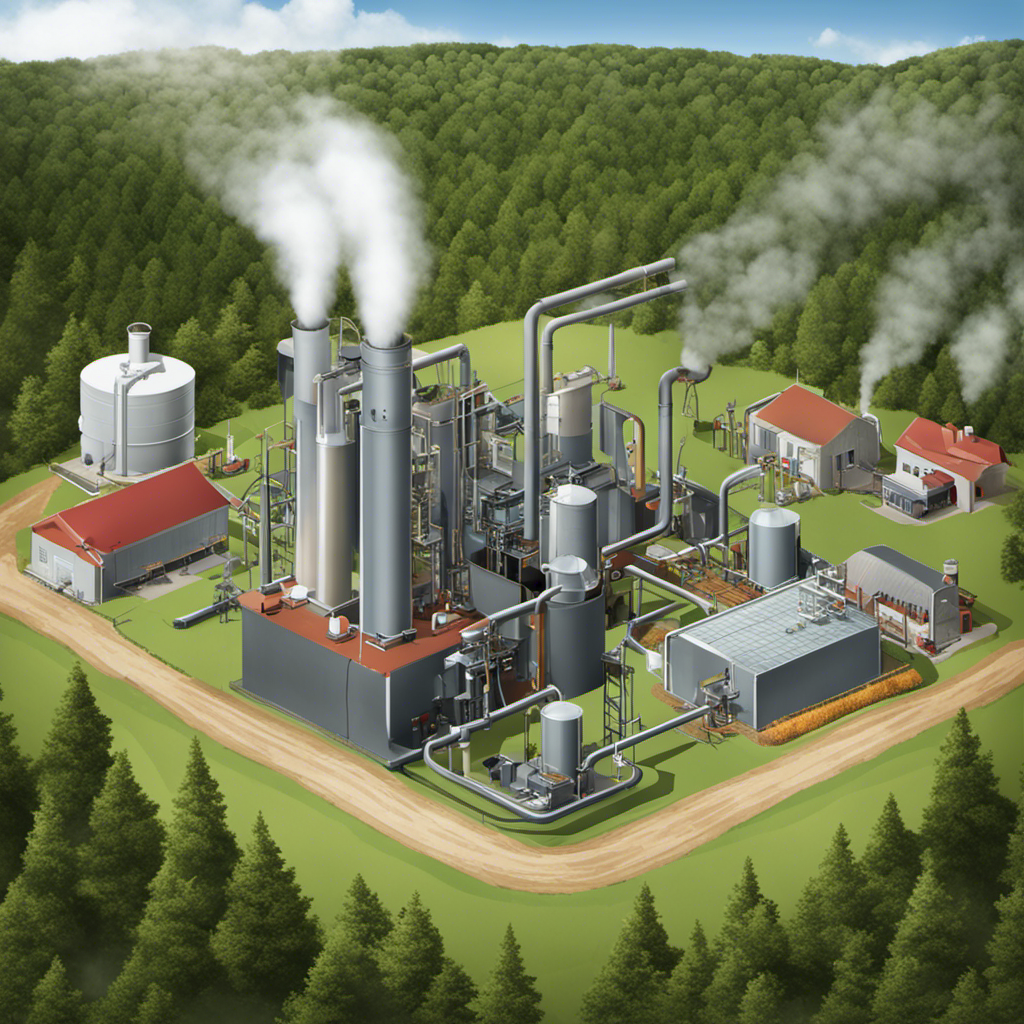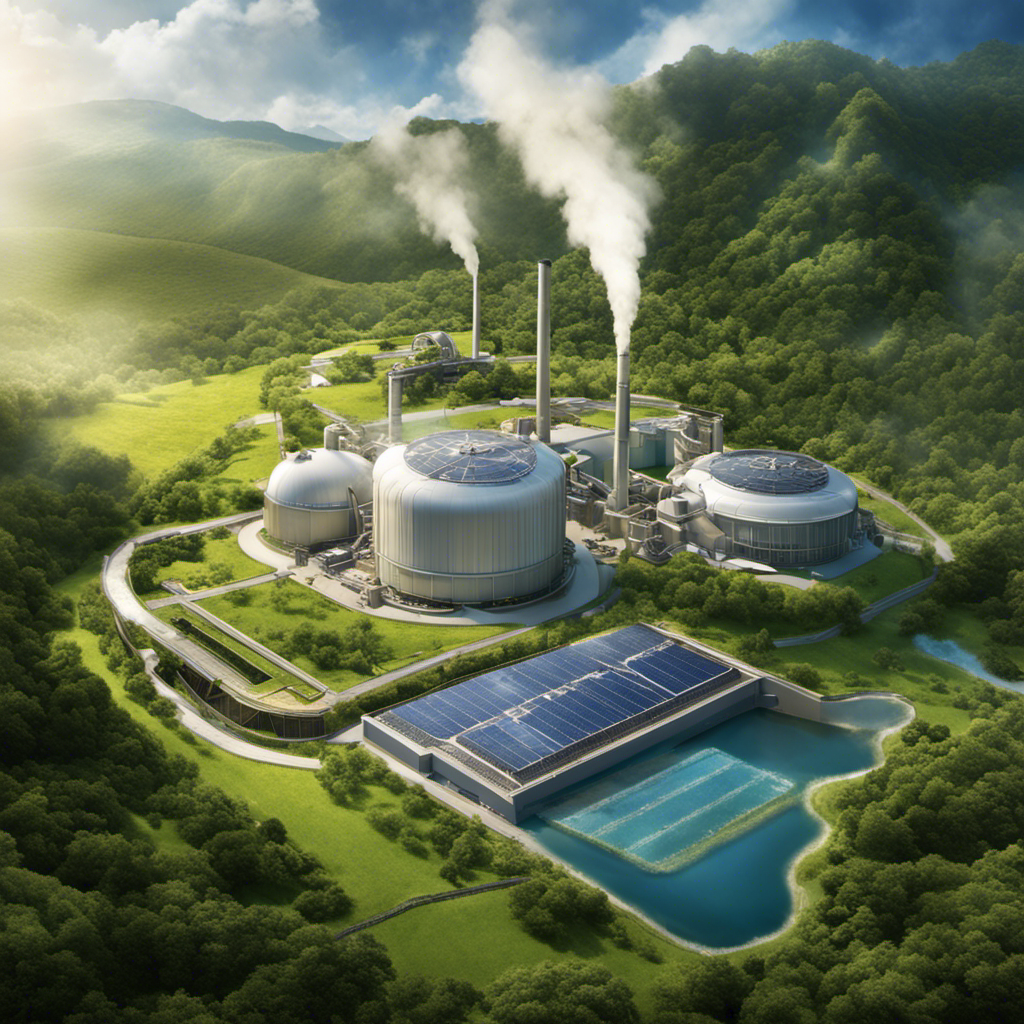Understanding Renewable Energy: What Renewable Energy Is, Its Importance, and Types
As I delve into the world of renewable energy, I can’t help but be amazed by its potential. It’s not just about saving the planet; it’s about embracing a sustainable future.
In this article, we’ll explore what renewable energy is, why it matters, and the various types that exist. We’ll also examine the advantages and disadvantages, the role of government, and how renewable energy is making its way into our homes and businesses.
Get ready to be enlightened and inspired by the power of renewables.
Key Takeaways
- Renewable energy is derived from natural resources like sunlight, wind, and water and is clean, sustainable, and doesn’t contribute to greenhouse gas emissions.
- It offers environmental benefits by reducing greenhouse gas emissions, improving air quality, and promoting sustainability by reducing dependence on finite fossil fuels.
- Renewable energy presents economic opportunities by creating jobs, driving innovation, and boosting the local economy. It also contributes to a sustainable future for generations to come.
- Advancements in renewable energy technologies have made them more efficient and cost-effective, reducing dependence on fossil fuels, lowering carbon emissions, and creating job opportunities.
The Basics of Renewable Energy
Renewable energy is a type of energy that is derived from natural resources, such as sunlight, wind, and water. It is an important alternative to traditional fossil fuels because it is clean, sustainable, and does not contribute to greenhouse gas emissions.
Renewable energy sources include solar power, wind power, hydropower, biomass, and geothermal energy. These sources are abundant and can be replenished naturally, making them a reliable and long-term solution to our energy needs.
Renewable energy technologies have made significant advancements in recent years, making them more efficient and cost-effective. Solar energy, for example, uses photovoltaic cells to convert sunlight into electricity. Wind turbines harness the power of the wind to generate electricity, while hydropower plants use flowing water to spin turbines and produce energy. Biomass energy is generated from organic materials, such as wood, agricultural waste, and landfill gas. Geothermal energy utilizes the heat from the earth’s core to generate electricity or heat buildings.
The adoption of renewable energy is essential for reducing our dependence on fossil fuels and mitigating climate change. It not only helps to lower carbon emissions but also promotes energy independence and creates new job opportunities. As renewable energy technologies continue to improve and become more accessible, it is crucial for governments, businesses, and individuals to invest in and support these sustainable alternatives.
Why Renewable Energy Matters
Renewable energy is a crucial topic to discuss due to its various benefits. Firstly, it offers significant environmental benefits by reducing greenhouse gas emissions, improving air quality, and conserving natural resources.
Secondly, it promotes energy independence by diversifying our energy sources and reducing our reliance on fossil fuels.
Lastly, renewable energy presents economic opportunities by creating jobs, driving innovation, and boosting the local economy.
Overall, understanding the importance of renewable energy is essential for a sustainable future.
Environmental Benefits
If you’re looking to reduce your carbon footprint and protect the environment, using renewable energy sources can significantly contribute to those efforts. Renewable energy is a sustainable and clean form of energy that comes from natural sources such as the sun, wind, water, and geothermal heat.
Here are some environmental benefits of using renewable energy:
-
Reducing carbon emissions: Renewable energy sources produce little to no greenhouse gas emissions, helping to combat climate change and reduce air pollution.
-
Promoting sustainability: By using renewable energy, we can reduce our dependence on finite fossil fuels and ensure a more sustainable future for generations to come.
-
Preserving natural resources: Renewable energy sources are abundant and do not deplete the Earth’s natural resources like fossil fuels do.
-
Protecting ecosystems: Unlike conventional energy sources, renewable energy does not require destructive extraction processes that harm ecosystems and wildlife.
-
Mitigating environmental risks: Renewable energy helps to diversify our energy mix, reducing the risks associated with traditional energy sources such as oil spills and nuclear accidents.
Energy Independence
Using renewable energy sources can help countries achieve energy independence by reducing reliance on imported fossil fuels.
Renewable energy is not only a sustainable option, but it also provides numerous benefits for nations.
One of the key advantages is improved energy efficiency. Renewable sources like solar and wind power have the potential to convert energy more efficiently than traditional methods, leading to reduced energy wastage.
Additionally, adopting renewable energy can significantly contribute to reducing carbon emissions, as these sources produce little to no greenhouse gases. This is crucial in combating climate change and promoting a cleaner environment.
Economic Opportunities
Investing in renewable energy technologies can open up new economic opportunities for you. This allows you to tap into the growing market for clean energy solutions. Here are five reasons why investing in renewable energy can lead to economic growth and job creation:
- Increased demand for renewable energy solutions creates a need for skilled workers in the industry.
- Renewable energy projects often require local labor, leading to job creation in the community.
- The development and manufacturing of renewable energy technologies can stimulate economic growth by attracting investments and creating new businesses.
- Transitioning to renewable energy can reduce dependence on fossil fuels, leading to cost savings and economic stability.
- By investing in renewable energy, countries can become leaders in the clean energy sector. This attracts international investments and fosters innovation.
Exploring Different Types of Renewable Energy
When it comes to renewable energy, there are several options to consider. Solar power offers numerous benefits, including reducing greenhouse gas emissions and providing a reliable source of electricity.
Wind energy has its advantages as well, such as being a clean and abundant resource that can help mitigate climate change.
Geothermal energy, on the other hand, has applications beyond just generating electricity, including heating and cooling systems for buildings.
Overall, these three types of renewable energy play a crucial role in our transition to a sustainable future.
Solar Power Benefits
You can save money on your electricity bills by harnessing the power of solar energy. Solar power offers several benefits that make it a popular choice for renewable energy.
Here are some key advantages:
- Solar power is highly efficient, converting sunlight into electricity with minimal loss.
- It provides a clean and sustainable source of energy, reducing our dependence on fossil fuels and lowering carbon emissions.
- Solar panels can be installed on rooftops, making use of space that would otherwise be unused.
- With advancements in technology, solar energy storage solutions are becoming more efficient, allowing homeowners to store excess energy for use during cloudy days or at night.
- Solar power systems have a long lifespan and require minimal maintenance, making them a cost-effective option in the long run.
Transitioning to the next section, let’s now explore the advantages of wind energy.
Wind Energy Advantages
Transitioning to the advantages of wind energy, it’s important to note that wind power offers numerous benefits as a renewable energy source.
One key advantage is its high energy efficiency. Wind turbines can convert up to 45% of the wind’s kinetic energy into electricity, making it a highly efficient form of renewable energy.
Another advantage is the versatility of wind turbine design. These structures can be built onshore or offshore, and can vary in size and capacity to fit different locations and energy needs.
Additionally, wind energy is abundant and widely available, reducing our reliance on finite fossil fuel resources. It also produces no greenhouse gas emissions or air pollutants during operation, making it a clean and environmentally friendly option.
Overall, wind energy provides a promising and sustainable solution for our energy needs.
Geothermal Energy Applications
To fully harness the benefits of geothermal energy, it’s crucial to explore its various applications and how they can be implemented in your everyday life. Geothermal energy is a renewable energy source that utilizes the heat from the Earth’s core to generate electricity and heat buildings.
Here are some of its applications:
-
Heating and cooling systems: Geothermal heat pumps use the stable temperature of the ground to efficiently heat and cool buildings, providing both comfort and energy savings.
-
Electricity generation: Geothermal power plants harness the steam or hot water from underground to drive turbines and generate electricity, offering a reliable and sustainable energy source.
-
Industrial processes: Geothermal energy can be used in various industrial processes, such as drying crops, desalinating water, and powering manufacturing operations, reducing reliance on fossil fuels.
-
District heating: Geothermal energy can supply heat to entire communities through district heating systems, reducing greenhouse gas emissions and promoting energy efficiency.
-
Spa and wellness industry: Geothermal hot springs and spas offer therapeutic benefits and relaxation, attracting tourists and contributing to local economies.
Geothermal energy efficiency and technology advancements continue to improve, making it an increasingly viable and sustainable energy option for a greener future.
Advantages and Disadvantages of Renewable Energy
One of the advantages of renewable energy is that it produces lower greenhouse gas emissions compared to fossil fuels. This is a significant benefit as reducing greenhouse gas emissions is crucial in combating climate change. Renewable energy sources such as solar, wind, hydro, and geothermal power do not release harmful pollutants into the atmosphere during the generation process. This helps to mitigate the negative environmental impacts associated with traditional energy sources.
In addition to lower greenhouse gas emissions, renewable energy offers several other pros. Firstly, it is a sustainable and inexhaustible source of power. Unlike fossil fuels, which are finite resources, renewable energy sources can be replenished naturally. This ensures a more reliable and long-term energy supply. Moreover, renewable energy technologies have the potential to create jobs and stimulate economic growth. The transition towards a renewable energy system can generate employment opportunities across various sectors, from manufacturing and installation to maintenance and research.
However, it is important to consider the cons and sustainability challenges associated with renewable energy. One key drawback is the intermittent nature of certain renewable sources, such as solar and wind power. Their generation is dependent on weather conditions, which can result in fluctuations in output. This variability presents challenges in terms of grid integration and stability. Additionally, the initial costs of implementing renewable energy systems can be high, although the long-term benefits often outweigh the upfront investments.
Overall, the advantages of renewable energy, including lower greenhouse gas emissions, sustainability, and job creation, make it a viable and attractive alternative to fossil fuels. While there are challenges to overcome, continued advancements in technology and supportive policies can further enhance the benefits of renewable energy in the future.
Renewable Energy and Climate Change
Now that we have discussed the advantages and disadvantages of renewable energy, let’s explore its impact on two important areas: public health and job creation.
Renewable energy plays a crucial role in addressing climate change, which is directly linked to public health. By reducing greenhouse gas emissions, renewable energy sources help to mitigate the effects of climate change, such as extreme weather events and air pollution. This, in turn, leads to improved public health outcomes, including reduced respiratory illnesses and cardiovascular diseases.
Moreover, the transition to renewable energy creates job opportunities in various sectors. Here are five ways renewable energy promotes job creation:
- Installation and maintenance of renewable energy systems
- Manufacturing of renewable energy technologies and equipment
- Research and development of new renewable energy technologies
- Energy efficiency upgrades and retrofits in buildings
- Green construction and infrastructure projects
By investing in renewable energy, governments and businesses can stimulate economic growth and create sustainable jobs for communities.
As we continue our exploration of renewable energy, let’s now shift our focus to the role of government in promoting its adoption and development.
The Role of Government in Promoting Renewable Energy
The government’s role in promoting renewable energy is crucial for accelerating the transition to a sustainable and clean energy future. Through government incentives and renewable energy policies, the government plays a pivotal role in driving the adoption and development of renewable energy sources.
Government incentives, such as tax credits and grants, provide financial support to individuals and businesses that invest in renewable energy technologies. These incentives help to offset the higher upfront costs associated with renewable energy systems, making them more accessible and attractive to consumers. By reducing the financial barriers, the government encourages the widespread adoption of renewable energy and facilitates the transition away from fossil fuels.
Renewable energy policies, on the other hand, set the framework for renewable energy development and deployment. These policies establish targets and mandates for renewable energy generation, as well as regulations and standards to ensure the integration and reliability of renewable energy sources into the existing energy infrastructure. By creating a supportive policy environment, the government provides stability and certainty for renewable energy investors and developers, fostering innovation and driving technological advancements in the sector.
Renewable Energy in Residential Settings
Government incentives, such as tax credits and grants, make renewable energy more accessible and attractive to homeowners and businesses. These incentives play a crucial role in promoting the adoption of renewable energy technologies in residential settings.
Here are some key ways in which residential solar and small wind turbines are being utilized:
-
Energy cost savings: Installing solar panels or small wind turbines at home can significantly reduce electricity bills. By generating clean energy on-site, homeowners can offset their reliance on traditional grid electricity and reduce their monthly expenses.
-
Environmental benefits: Residential solar and small wind turbines help decrease dependence on fossil fuels, reducing greenhouse gas emissions and air pollution. By embracing renewable energy, homeowners can contribute to a cleaner and more sustainable environment.
-
Energy independence: Generating electricity from renewable sources allows homeowners to become more self-sufficient and less reliant on the power grid. This independence provides peace of mind during power outages or fluctuations in energy prices.
-
Increased property value: Research has shown that homes with solar panels or small wind turbines tend to have higher property values. These renewable energy systems are seen as desirable features that attract potential buyers.
-
Job creation: The growing demand for residential solar and small wind turbines has created job opportunities in the renewable energy sector. From installation to maintenance, these technologies require skilled workers, contributing to local economies.
Renewable Energy in Commercial and Industrial Applications
Businesses across various industries are increasingly adopting renewable energy solutions to reduce their carbon footprint and lower operating costs. This trend is evident not only in residential settings but also in commercial and industrial applications. One area where renewable energy is gaining traction is in transportation. Companies are recognizing the environmental and economic benefits of using renewable energy sources to power their fleets. Electric vehicles (EVs) are becoming more common, and businesses are installing charging stations to support their use. This shift towards renewable energy in transportation is helping to reduce greenhouse gas emissions and decrease reliance on fossil fuels.
Another industry where renewable energy is making a significant impact is agriculture. Farmers are embracing renewable energy solutions to power their operations. Solar panels are being installed on rooftops and open fields, providing clean and sustainable energy to run irrigation systems, barns, and other agricultural equipment. Additionally, wind turbines are being utilized to generate electricity in rural areas, where wind resources are abundant. Renewable energy in agriculture not only reduces environmental impact but also helps farmers save on energy costs, allowing them to invest in other areas of their businesses.
Future Trends and Innovations in Renewable Energy
Renewable energy has already made significant strides in commercial and industrial applications, but what does the future hold for this rapidly evolving sector? Let’s take a look at some of the future trends and technological advancements that are expected to shape the renewable energy landscape.
-
Battery storage technology: As renewable energy sources like solar and wind become more prevalent, the need for efficient energy storage solutions is growing. Advancements in battery technology will allow for better integration of intermittent renewable energy into the grid.
-
Smart grid technology: The integration of renewable energy into the existing power grid requires a more intelligent and flexible infrastructure. Smart grid technology will enable real-time monitoring and control of energy flow, optimizing the use of renewable resources.
-
Artificial intelligence (AI) and machine learning: AI and machine learning algorithms can analyze vast amounts of data to optimize renewable energy systems. These technologies will help predict energy generation and consumption patterns, improving overall efficiency.
-
Hydrogen fuel cells: Hydrogen fuel cells have the potential to revolutionize the energy industry. They offer a clean and efficient way to store and transport energy, making them a promising technology for the future.
-
Offshore wind power: Offshore wind farms have the advantage of stronger and more consistent winds, making them a viable option for generating large amounts of renewable energy. Technological advancements in offshore wind turbine design and installation will further increase their efficiency and capacity.
The future of renewable energy is bright, with ongoing advancements and emerging technologies set to revolutionize the way we generate, store, and consume energy. These trends and innovations will play a crucial role in accelerating the transition to a sustainable and renewable future.
Frequently Asked Questions
How Much Does It Cost to Install Renewable Energy Systems in Residential Settings?
The cost of installing renewable energy systems in residential settings varies depending on several factors. A cost analysis is necessary to determine the specific expenses involved, such as equipment, installation, and maintenance.
However, it is important to note that while the initial investment may be higher compared to traditional energy sources, the long-term financial benefits of renewable energy, such as reduced energy bills and potential incentives, can outweigh the upfront costs.
Are There Any Government Incentives or Subsidies Available for Promoting Renewable Energy?
There are government incentives and subsidies available to promote renewable energy. These financial support programs aim to encourage individuals and businesses to adopt renewable energy technologies by offering financial assistance or tax benefits.
One interesting statistic is that according to the International Energy Agency, global government subsidies for renewable energy reached $147 billion in 2019. These incentives not only help reduce the cost of renewable energy systems but also contribute to the growth and development of a sustainable and clean energy future.
How Does Renewable Energy Contribute to Job Creation?
Renewable energy plays a crucial role in job creation and brings significant economic benefits. The renewable energy job market is rapidly expanding, providing opportunities for skilled workers in various sectors such as solar, wind, and hydroelectric power.
This growth in employment is driven by the increasing demand for clean energy sources and the need to reduce carbon emissions. Additionally, the renewable energy industry stimulates local economies through investments, infrastructure development, and long-term sustainable growth.
Can Renewable Energy Sources Be Used to Power Large-Scale Industrial Operations?
Yes, renewable energy sources can certainly be used to power large-scale industrial operations. With advancements in renewable energy technology, such as solar and wind power, it is becoming increasingly feasible to meet the energy demands of industries while reducing carbon emissions.
This is particularly important in developing countries, where access to reliable and affordable energy is crucial for economic growth. By harnessing the power of renewable energy, these countries can not only meet their energy needs but also contribute to a more sustainable future.
What Are the Potential Risks and Challenges Associated With Integrating Renewable Energy Into the Existing Power Grid?
Integrating renewable energy into the existing power grid presents potential risks and challenges. One interesting statistic is that in 2020, renewable energy sources accounted for 20% of the total electricity generated worldwide. This highlights the growing importance of renewable energy in our energy mix.
However, one challenge is maintaining grid stability. Renewable energy sources like solar and wind can be intermittent, requiring careful management to ensure a reliable power supply.
Additionally, the existing power grid may need upgrades to accommodate the increased transmission capacity required for renewable energy integration.
Conclusion
In conclusion, renewable energy is a crucial component of our future. It provides clean and sustainable power that helps combat climate change and reduces our dependence on fossil fuels.
Just like a ray of sunshine breaking through the clouds, renewable energy brings hope and promises a brighter future for generations to come.
With advancements in technology and the support of governments, we can continue to harness the power of renewable energy and make a positive impact on our planet.
Let’s embrace this renewable revolution and pave the way for a greener tomorrow.

















